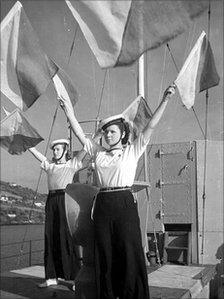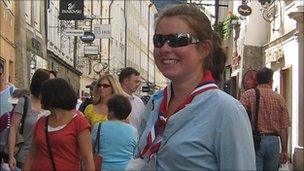How the Girl Guides knitted, nursed and dug for victory
- Published

Knitting, baking and singing hymns. That's what the Girl Guides is all about, right? Well, not according to a new book which tells the little-known story of the huge contributions that Guides made in World War II.
The moment that war was declared in 1939, Margaret Collins, at the time a guide living in Maidstone, Kent, knew exactly where she was - helping out in the town hall, where she listened in the Mayor's parlour to the declaration of war.
"Various information offices were set up and I helped direct the evacuees," she says. "First, we Guides scrubbed the large old houses along the London Road, which had stood empty because of the Depression. They were taken over by the council and we got them ready for pregnant mothers.
"We hardly went to school at all, even though it was my last year. Once air-raid shelters had been dug and blast walls put up, then we got back to school."
Margaret was one of 750,000 Guides in the UK when war broke out. Suddenly, there was a huge pool of skilled girls and young women willing to contribute to the war effort.
Guides were earning badges as proficient electricians, mechanics, first-aiders, and signallers. The telegraphist badge required them to construct their own wireless receiver and send messages in Morse code at a speed of 30 letters per minute.
This training meant they had basic skills in many fields, which could be put to good use in the country's moment of need.
Margaret's story, and many like hers, are told in How Girl Guides Won the War, by Janie Hampton.
With the men away and older women called up to the Women's Auxiliary Air Force, Women's Royal Navy, and the Female Aid Nursing Yeomanry, Guides stepped in as much needed nursery nurses and teachers.
It sometimes took the initiative of those in authority to spot the potential of Guides. Hampton's book reveals how, for example, the vicar of Claybury Park in Ilford, Essex, asked Guides to run a nursery in his church hall.
Elsewhere, they distributed gas masks, whitewashed kerbs so people could find their way in a blackout, kept up morale in bomb shelters with songs, and raised funds to buy ambulances and lifeboats.
The government also realised it had a home army of willing volunteers. The Ministry of Food asked Guides to demonstrate Blitz cooking to Londoners. This entailed constructing emergency ovens out of bricks from bombed houses. Guides also shared the wartime recipes they had invented, for instance, mock fishcakes made from potato and anchovy sauce.
"It was that ability to use your imagination with what was available," says Ms Hampton. "But you can't have imagination if you haven't already made lots of campfires and learnt how to do it."
Guides knitted socks for soldiers and helped in the national campaign to "dig for victory". And refugees and evacuees were assigned to Guide companies.

Guides practise their signalling
"Guides helped refugees by being something familiar in a time of great change and displacement," says Ms Hampton. "It became a family to many girls, providing them with structure in the form of patrols, achievements in the form of proficiency badges, and friendships that often lasted their whole lives."
These skills proved essential to every individual Guide during WW2, but also to the entire war effort.
Mrs Betty Wiggins-Jones, who was 16 and a lieutenant of the Cheltenham Guide Company when war broke out, accumulated badges for sewing, Red-Cross, and camping amongst others. "The skills we learned at Guides helped us during the war - even just to be self-reliant.
"Guides gave us a strength of character, and taught us to be independent and cheerful. Keeping up the morale of the country was very important in those days, very important."
In Guide companies, royalty mixed with the daughters of the working classes, breaking down the social barriers so fastidiously upheld by the Victorians.
Ms Hampton believes that in many ways the Girl Guiding movement has been a driving force in the fight for women's equality.
When it began in 1909, girls were not supposed to run, or even raise their arms above their head, but soon Guides were learning to swim, cycle, and shoot.
"At a time when most girls would have left school at 14, this was a form of formal education. There were no organised evening classes or Open University. Girls could leave school at 14, go into service or work in a factory, and then could get more qualifications through Guides, which would lead to other jobs."
Since the war, Guides have been thought of as rather "uncool", says Ms Hampton, and their contribution to British life forgotten.
Nineteen-year-old Steph Wooller, leader of the 1st Hellingly Brownies in Sussex East, says she hopes the "incredible" history of Guiding can change people's perceptions.

"I saw a BBC documentary on 100 years of Guiding, which introduced me to the history behind Guiding. But I certainly didn't have any idea of the extent to which they were involved in the war effort. I think it's really interesting. Our heritage is really something to be proud of.
"Girls think they'll be learning knitting, or knotting, or doing semaphore, she adds, but the majority of the time you're street dancing, or doing floristry - whatever you want really. We're trying to get away from that bad stereotype."
For Ms Hampton, the process of compiling her book changed her view.
"It made me feel a lot more proud of Guides and realise what a jolly good thing they are".